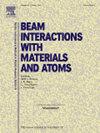TCAD simulation method on single-event burnout of SiC JBS diodes
IF 1.4
3区 物理与天体物理
Q3 INSTRUMENTS & INSTRUMENTATION
Nuclear Instruments & Methods in Physics Research Section B-beam Interactions With Materials and Atoms
Pub Date : 2025-07-10
DOI:10.1016/j.nimb.2025.165797
引用次数: 0
Abstract
The Silicon Carbide (SiC) Junction Barrier Schottky (JBS) diode is susceptible to Single-Event Burnout (SEB) during heavy ion events. To deepen the comprehension of the mechanisms behind SEB, a reasonable simulation method is introduced, where a TCAD device model is established with a good agreement with measured electric characteristics, the Gaussian eigenvalues of the heavy ion transportation energy distribution in the vertical track direction are determined by the Geant4 simulation, and the surface heat dissipation is considered. The simulation method is verified by experiment results. According to experiment results, under SEB condition, the simulated temperature of Tpeak_SiC (K) is in the range of 2093 ∼ 3341 K, the simulated temperature of Tpeak_contact (K)is in the range of 1081 ∼ 1465 K, and the cause of this variation range has been analyzed and discussed.
SiC JBS二极管单事件烧蚀的TCAD仿真方法
碳化硅(SiC)结势垒肖特基(JBS)二极管在重离子事件中容易发生单事件烧坏(SEB)。为了加深对SEB机理的理解,引入了一种合理的模拟方法,建立了与实测电特性吻合较好的TCAD装置模型,通过Geant4模拟确定了重离子在垂直轨道方向输运能量分布的高斯特征值,并考虑了表面散热。实验结果验证了仿真方法的正确性。根据实验结果,在SEB条件下,Tpeak_SiC (K)的模拟温度在2093 ~ 3341 K范围内,Tpeak_contact (K)的模拟温度在1081 ~ 1465 K范围内,并对该变化范围的原因进行了分析和讨论。
本文章由计算机程序翻译,如有差异,请以英文原文为准。
求助全文
约1分钟内获得全文
求助全文
来源期刊
CiteScore
2.80
自引率
7.70%
发文量
231
审稿时长
1.9 months
期刊介绍:
Section B of Nuclear Instruments and Methods in Physics Research covers all aspects of the interaction of energetic beams with atoms, molecules and aggregate forms of matter. This includes ion beam analysis and ion beam modification of materials as well as basic data of importance for these studies. Topics of general interest include: atomic collisions in solids, particle channelling, all aspects of collision cascades, the modification of materials by energetic beams, ion implantation, irradiation - induced changes in materials, the physics and chemistry of beam interactions and the analysis of materials by all forms of energetic radiation. Modification by ion, laser and electron beams for the study of electronic materials, metals, ceramics, insulators, polymers and other important and new materials systems are included. Related studies, such as the application of ion beam analysis to biological, archaeological and geological samples as well as applications to solve problems in planetary science are also welcome. Energetic beams of interest include atomic and molecular ions, neutrons, positrons and muons, plasmas directed at surfaces, electron and photon beams, including laser treated surfaces and studies of solids by photon radiation from rotating anodes, synchrotrons, etc. In addition, the interaction between various forms of radiation and radiation-induced deposition processes are relevant.

 求助内容:
求助内容: 应助结果提醒方式:
应助结果提醒方式:


